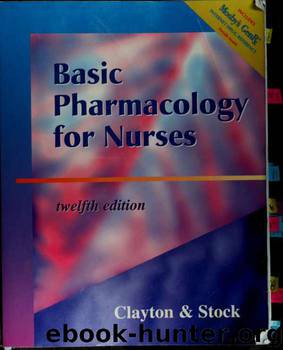Basic pharmacology for nurses by unknow

Author:unknow
Language: eng
Format: epub
Tags: Pharmacology, Nursing
Publisher: St. Louis : Mosby
Published: 2001-06-30T19:00:00+00:00
malleolus. Weigh the patient daily using the same scale, at the same time, in similar clothing.
Edema. Edema is a term used to describe excess fluid accumulation in the extracellular spaces. Edema is considered "'pitting" when an indentation remains in the tissue after pressure is exerted against a bony part, such as the shin, ankle, or sacrum. The degree is usually recorded as 1 + (slight) to 4+ (deep).
Pale, cool, tight, shiny skin is another sign of edema. Also listen to lung sounds to detect the presence of excess fluid.
Assess for the presence of edema (record degree of pitting), obtain baseline measurement of abdominal girth when edema is present, and check for the presence of fluid waves in the abdomen.
Electrolyte imbalance: Because the symptoms of most electrolyte imbalances are similar, the nurse should gather data relative to changes in the patient's mental status (alertness, orientation, confusion), muscle strength, muscle cramps, tremors, nausea, and general appearance.
Susceptible People. Those who are particularly susceptible to the development of electrolyte disturbances frequently have a history of renal or cardiac disease, hormonal disorders, or massive trauma or burns or are receiving diuretic or steroid therapy. Review available electrolyte studies.
Hypokalemia. Serum potassium (K + ) levels below 3.5 mEq/L. Hypokalemia is especially likely to occur when a patient exhibits vomiting, diarrhea, or heavy diuresis. All diuretics, except the potassium-sparing type, are likely to cause hypokalemia.
Hyperkalemia. Serum potassium (K + ) levels above 5.5 mEq/L. Hyperkalemia occurs most commonly when a patient is given excessive amounts of potassium supplementation, either intravenously or orally. It may also occur as an adverse effect of potassium-sparing diuretics.
Hyponatremia. Serum sodium (Na + ) below 135 mEq/L. Remember the phrase, "Where sodium goes, water goes." Because diuretics act by excreting sodium, monitor the patient for hyponatremia during and after diuresis.
Hypernatremia. Serum sodium (Na + ) above 145 mEq/L. Hypernatremia occurs most frequently when a patient is given intravenous (IV) fluids in excess of fluid excreted.
Nursing Diagnosis
Fluid volume excess (indication) Cardiac output, decreased (indication) Fluid volume deficit (side effect) Injury, risk for (side effect)
Planning
History of causative disorder/factors: Review the patient's history to identify the underlying diagnosis lor which the diuretic is prescribed.
History of current symptoms: Plan to perform a focused assessment at least every shift to identify any changes in the patient's status.
Pattern of urination: Schedule appropriate nursing interventions for identified problems relating to the pattern of urinary elimination. Be sure to provide assistance with voiding for persons with impaired mobility, fatigue, or another impairment.
Medications: Schedule prescribed medications on the medication administration record (MAR). Remember to administer diuretics in the morning whenever possible to prevent nocturia. Hydration: Schedule intake and output (I&O) every shift or more frequently depending on patient status. Place information to be assessed for status of hydration on the Kardex (e.g., measure abdominal girth every shift, record degree of edema present in legs every shift).
Renal diagnostics: Many laboratory tests are ordered throughout the treatment of renal dysfunction (BUN, serum creatinine, creatinine clearance, serum osmolalities, urine osmolalities). Plan schedules for appropriate timing of collections of blood and urine samples.
Download
This site does not store any files on its server. We only index and link to content provided by other sites. Please contact the content providers to delete copyright contents if any and email us, we'll remove relevant links or contents immediately.
The Art of Coaching Workbook by Elena Aguilar(50989)
Trainspotting by Irvine Welsh(21519)
The Secret History by Donna Tartt(18849)
Twilight of the Idols With the Antichrist and Ecce Homo by Friedrich Nietzsche(18503)
All the Missing Girls by Megan Miranda(15579)
Cat's cradle by Kurt Vonnegut(15186)
Ready Player One by Cline Ernest(14525)
Talking to Strangers by Malcolm Gladwell(13222)
Fangirl by Rainbow Rowell(9097)
The remains of the day by Kazuo Ishiguro(8823)
The Compound Effect by Darren Hardy(8810)
Thirteen Reasons Why by Jay Asher(8796)
Tools of Titans by Timothy Ferriss(8218)
Periodization Training for Sports by Tudor Bompa(8170)
Wonder by R. J. Palacio(8010)
The Lover by Duras Marguerite(7830)
A Court of Wings and Ruin by Sarah J. Maas(7652)
Change Your Questions, Change Your Life by Marilee Adams(7635)
The Complete Stick Figure Physics Tutorials by Allen Sarah(7307)
